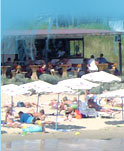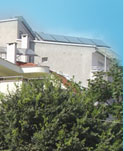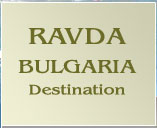
BURGAS
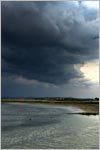 Bourgas lakes form the largest and most valuable wetland complex in Bulgaria. Their total surface area (together with the marshes, bogs, fish ponds and other water bodies) reaches up to 9500 ha, of which 3330 ha have already been designated as protected areas or proposals have been submitted for their designation as such areas. Along with the significant amounts of various natural resources like fish, game animals, reed, salt, medicinal mud, lye, etc. found in them, these wetlands are distinguished by their exceptionally rich biodiversity. This variety of life forms and habitats has been known since the last century when travellers, naturalists and ornithologists from abroad have found themselves in a close touch with the unique diversity of the lakes and have described them in their diaries, books and research papers. Bourgas lakes form the largest and most valuable wetland complex in Bulgaria. Their total surface area (together with the marshes, bogs, fish ponds and other water bodies) reaches up to 9500 ha, of which 3330 ha have already been designated as protected areas or proposals have been submitted for their designation as such areas. Along with the significant amounts of various natural resources like fish, game animals, reed, salt, medicinal mud, lye, etc. found in them, these wetlands are distinguished by their exceptionally rich biodiversity. This variety of life forms and habitats has been known since the last century when travellers, naturalists and ornithologists from abroad have found themselves in a close touch with the unique diversity of the lakes and have described them in their diaries, books and research papers.
Click here to view more pictures
ATANASOVSKO LAKE
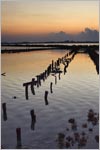 Atanasovsko lake is a hyperhaline coastal lake divided in two parts by the Bourgas – Varna motorway. The northern part was declared a nature reserve in the early 1980-ies, while the southern part has later formed the reserve buffer zone. The lake total area is 1700 ha. It is surrounded by lesser water bodies and a system of ditches overgrown with marshy vegetation. Both parts of the lake have been turned into salt works in 1906. Atanasovsko lake is a hyperhaline coastal lake divided in two parts by the Bourgas – Varna motorway. The northern part was declared a nature reserve in the early 1980-ies, while the southern part has later formed the reserve buffer zone. The lake total area is 1700 ha. It is surrounded by lesser water bodies and a system of ditches overgrown with marshy vegetation. Both parts of the lake have been turned into salt works in 1906.
In Atanasovsko lake more than 233 species of plants have been found. The most typical ones are the Glasswort, Black Sea Lavender, Sea Wormwood, Broadleaf Bulrush, Sea Blite, etc.
Atanasovsko lake is indeed the bird paradise of Bulgaria. Over 300 species of birds have been found to occur there in the course of any single year. This makes nearly 3/4 of all the birds species found in Bulgaria (which are more than 400 as of today's data). Of those 300 species 12 are globally threatened: Dalmatian Pelican, Red-breasted Goose, Pygmy Cormorant, Ferruginous Duck and Corncrake being amongst the most frequently occurring there. Seventeen species of the birds breeding in Atanasovsko lake have been listed in Bulgaria's Red Book. Among them the most numerous are the Avocet (up to 500 breeding pairs), the Sandwich Tern (up to 1160 breeding pairs) and the Little Tern (up to 158 breeding pairs). The lake is the only breeding ground in Bulgaria for the Mediterranean Gull, for the Slender-billed Gull and for the Gull-billed Tern. It is also one of the very few breeding sites for the Collared Pratincole – the bird symbol of the Atanasovsko Lake. In winter large flocks of Shelducks (up to 4000 ind.), Mallards (up to 8000 ind.), Wigeons (over 4000 ind.) and other waterfowl concentrate there. The first artificial breeding “islands” in Bulgaria were built in the Atanasovsko lake with their present inhabitants – gulls and terns – having settled on them long ago.
Click here to view more pictures
Vaya Lake
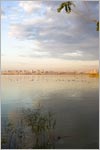 Vaya Lake This lake is an open firth (known also as Vaya lake) of roughly oval shape with maximum length of 9.6 km, maximum width of 4.5 km. and a surface area of 2760 ha. Its depth at places reaches 1.3 m. Thus the Bourgas lake is on the first place rated by size among the natural lakes in Bulgaria. It is separated from the sea by an extensive sand bar where the industrial sector of the town has been built on. Today the Bourgas lake is linked with the sea by a channel ending with a sluice. The rivulets Aitoska, Sandardere and Chukarska flow at the lake's western part. There are insignificant seasonal and annual fluctuations of the lake’s water level. Vaya Lake This lake is an open firth (known also as Vaya lake) of roughly oval shape with maximum length of 9.6 km, maximum width of 4.5 km. and a surface area of 2760 ha. Its depth at places reaches 1.3 m. Thus the Bourgas lake is on the first place rated by size among the natural lakes in Bulgaria. It is separated from the sea by an extensive sand bar where the industrial sector of the town has been built on. Today the Bourgas lake is linked with the sea by a channel ending with a sluice. The rivulets Aitoska, Sandardere and Chukarska flow at the lake's western part. There are insignificant seasonal and annual fluctuations of the lake’s water level.
A rich plant and animal life is a typical feature of the Bourgas lake. It is surrounded by a ring of reed growth which forms in the westernmost part a very large bed. More than 60 species of invertebrate have been found there along with over 20 fish species. So far 254 bird species have been recorded on and around the Vaya. Many of them are rare for Bulgaria or for Europe and 9 of them are among the globally threatened species. Some of the birds like Herons, Cormorants, Black-winged Stilts, Grebes breed there, while other species, mostly Ducks, Geese, Pelicans and Swans spend the winter or roost during migration. This was the main reason to put the lake in the European IBAs List.
Clickhere to view more pictures
MANDRA LAKE
Mandra Lake In the past being a brackish lake nowadays Mandra is a fresh-water reservoir with open water surface area of 3884 ha. It is 8 km long with a maximum width of 1.3 km. Mandra lake is situated in a well shaped river valley. Four rivulets flow in the lake: they are called Izvorska, Fakyiska, Sredetzka, Rusokastrenska. The major change of the lake came in 1963 when a dam was built in its eastern part. Till that moment the abundance of fish and waterfowl in the lake was tremendous and, mainly because of this, the lake was a favorite and a rather safe roosting place and feeding ground for hundred of thousands of migrating birds.
With water level rising the lake shallows, overgrown before with marshy vegetation soon disappeared, the link with the sea was terminated and the lake turned entirely fresh-water. Large reed beds were also gone and so was the great variety of nesting niches for waterfowl and other aquatic species of birds. Thus the only breeding colony of White Pelicans in Bulgaria was eliminated.
Mandra lake banks touch the northernmost slopes of Strandzha mountain. They are covered with a typical forest vegetation: Wild Peony, Snowdrop, Crocus.
The most valuable parts of the lake have been placed under legal protection like the mouth of rivulet Izvorska (with 151 ha of surface area protected), or have been proposed for legal protection like the countryside Uzun-Geren (with an area of 210 ha).
POMORIE LAKE
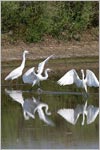 Pomorie Lake This is the northernmost of all Bourgas lakes. It is a hyperhaline naturally formed lagoon and is situated in closest vicinity to the town of Pomorie, separated from the sea by a sand bar and a manmade dike. There is a canal in its southern part connecting the lake with the Black sea. The lake surface area is 850 ha but together with the surrounding wetlands adds up to about 1000 ha. Its shape is one of the elongated oval the length of it along the long axis being 6.7 km and the average width being about 2 km. In the southern part of the lake medicinal mud is excavated while its northern part has been turned into salt works. Pomorie Lake This is the northernmost of all Bourgas lakes. It is a hyperhaline naturally formed lagoon and is situated in closest vicinity to the town of Pomorie, separated from the sea by a sand bar and a manmade dike. There is a canal in its southern part connecting the lake with the Black sea. The lake surface area is 850 ha but together with the surrounding wetlands adds up to about 1000 ha. Its shape is one of the elongated oval the length of it along the long axis being 6.7 km and the average width being about 2 km. In the southern part of the lake medicinal mud is excavated while its northern part has been turned into salt works.
The lake's water great salinity has determined the presence of specific plant and animal species: Glasswort, Sea Wormwood, Sea Blite, Caucasian Goby (a species of fish that can stand up to 80 promils water salinity), the Brine Shrimp (Artemia salina – an important component of the birds diet). Some rare plants listed in Bulgaria's Red Book like the Black Sea Campion, the Water Lily (Nymphaea alba), and others also occur there.
Click here to view more pictures
link
|
 |
